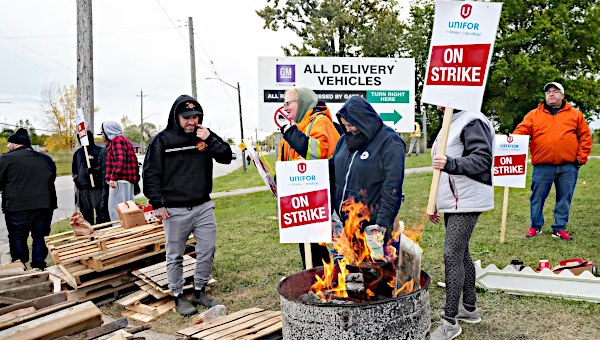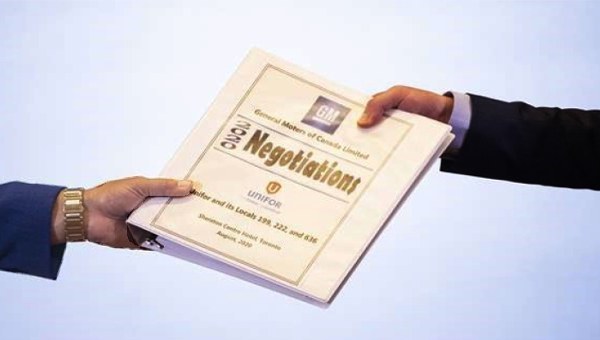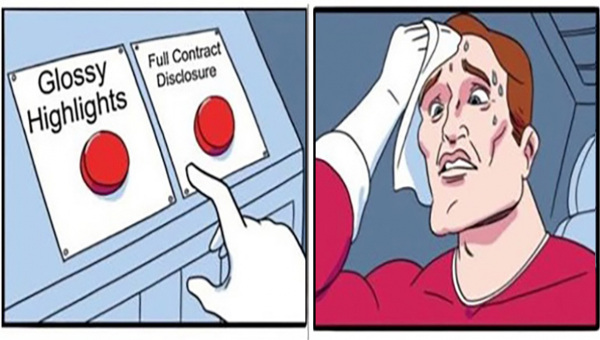Challenging the Framework for Concessions
At an October 26th unit meeting, scheduled to discuss proposals for amending the collective agreement – up for renegotiations in December – about 225 workers
from the Magna-owned Mississauga Seating unit of Canadian Auto Workers (CAW) Local 1256 turned down efforts to get them to buy-in to the notorious Framework for Fairness Agreement (FFA). Accepting the Framework would have represented a major step backwards for the unit. Specifically, they would have lost their elected in-plant representational structure which is currently independent of the company. In addition they would have lost the right to strike. Their refusal to accept the Framework sent a message to the CAW leadership, Magna and employers across Ontario, about the desire of workers to maintain their past gains and the independence of their union, in the face of the hard times. And we all are facing those increasingly difficult and insecure times today. Moreover, this rejection raises serious questions about the purpose of the Magna Framework, its future and the goals of Magna and the CAW leadership.
Defending Union Rights and the Collective Agreement
Since the FFA was first adopted by the CAW ten months ago, workers at Mississauga Seating were worried about possible efforts to force them to accept it. Leadership in the local union and in the workplace had been divided, but in a recent election, a new local president was elected. He gave support and encouragement to the activists and elected representatives in the plant that wanted to keep the Framework out.
Their initial concerns had to do with the terms of the Framework.
The FFA differs from normal union agreements in key areas: there would be no independent workplace union structure; instead of committeepersons or stewards, elected by union members and independent of the boss, there would be union members of a joint union-management committee called the “Fairness committee.” Union members of that committee could not act as independent union representatives. As well, there would be one union representative called an “Employee Advocate,” who would be selected through a circuitous process of vetting by union members of the Fairness committee and ultimately hand-picked by the assistant to the CAW President. She would never have to face an open, democratic election, but would be subject to a series of referendum votes. There would also be no right to strike in the agreement, with the bread and butter issues and many other contractual issues subject to binding arbitration. The issues of union structure and representation – key parts of the FFA – would not be subject to either strikes or arbitration and therefore, cannot be changed or amended without mutual agreement between the parties.
Aside from rejecting the terms of the Framework, workers at Mississauga Seating were concerned that they – with an already existing collective agreement that includes a system of independent union representatives as well as the right to strike – might be pressured to give up their current agreement in favour of the FFA.
The Magna-FFA had been originally justified as a strategy for organizing the anti-union employer. The argument went that the low density in the parts sector was making it increasingly difficult for the union to shape the terms of wages and benefits in the sector. Organizing the 18,000 workers in the parts giant Magna, would make a huge dent in that sector.
Historically, Magna owner Frank Stronach had been implacably opposed to unionization, although the union has been able to organize a couple of Magna units, using the opening created by CAW pressure on their customers, Chrysler and Ford and creative and determined organizing drives. Those plants – Mississauga Seating in Oakville and Integram, in Local 444 – each had traditional collective agreements.
The FFA committed Stronach to allow CAW organizing drives in a set number of plants per year, tied to a very different kind of collective agreement.
The FFA was endorsed in order to supposedly facilitate new organizing at Magna. Given the feverish arguments in favour of the strategy by the leadership, and the claims of its importance for the growth and security of the union, they, like the rest of us, were waiting for news of new organizing drives, based upon the FFA model.
Ten months later, there has been only one successful effort to use the FFA as a basis for organizing a non-unionized Magna unit (Qualtech, in London, which as organized in April). The Windsor Modules Plant, had been organized before the CAW Council meeting last December. One wonders why this hasn’t led to more efforts to organize new groups of workers under the FFA. Are they secretly in the works? Have they been attempted and failed?
As bargaining approached, representatives from the CAW national office began pressuring Mississauga Seating reps to accept the FFA as a basis for its upcoming round of collective bargaining this December.
Key leaders and elected shop floor reps at Mississauga Seating wanted to know how to protect their collective agreement and existing union structure and sought ways of involving the membership in any decision about changing them. The newly elected union executive was also concerned: a number of the defeated local leadership had been keen supporters of the Framework and the new officers had a mandate to respect the wishes of the members to prevent the Framework from undermining the independent union presence in the workplace.
They circulated both the Framework and criticisms, raised by CAW Members for Real Fairness, a coalition of CAW members and retirees that challenged the strategy in the buildup to and at the CAW Council meeting last September. When they were called to meetings at the national office, where efforts were made to “sell” the Framework, they refused.
When the local leadership notified CAW President Ken Lewenza of their opposition, he told the bargaining committee that it would be up to them and, at a meeting with the president, they voted to oppose the Framework, although the committee was divided.
Soon after, it was becoming clear to the local representatives, at a October 26th Unit meeting, scheduled for preparation and discussion of collective bargaining demands, that supporters of the Framework from Mississauga Seating would try and reverse the decision, along with help from the national union.
The local activists and elected shop floor leaders prepared to respond to the arguments of the proponents of the Framework, and held ongoing discussions on the shop floor with workers about the dangers of the agreement. Also participating in the preparatory discussions were members of the Workers for Union Renewal, a network of activists in the CAW, working to challenge the status quo and build internal democracy and class solidarity across the union movement.
In the workplace, they raised arguments such as:
- If the FFA was bargained to facilitate new organizing in Magna, why was there pressure for their already organized unit to gut their collective agreement in favour of the Framework?
- The Framework would do nothing to enhance the market position of the employer and had nothing to do with the ongoing crisis, gripping the world economy.
- The workers had fought for the right to independent union representation and the right to strike. Why should they be pressured to give it up?
- Another Magna unit, Integram in Local 444 also has a real collective agreement and has declined to participate in the Framework – why would they change?
- Perhaps the union and employer should prove to the workers that Framework can work as a way of organizing more units. After a couple of years of such organizing, perhaps then they would discuss participating in it.
- If it is proving to be impossible to use the Framework to organize new workers – and it is only being used to pressure already organized workplaces to accept it – then perhaps the FFA is useless and needs to be abandoned.
At the unit meeting, CAW President Lewenza and a group of national staff persons attended. Lewenza argued in favour of the Framework, referring to the current crisis across the economy and the industry, noting that now is the time to “change the way we do things.” A lively debate ensued, in which a number of speakers pointed out that the Framework had nothing to do with the current financial crisis and that any veiled threat to the future of the Mississauga Seating plant is nothing more than blackmail by the employer. The workers attending the meeting overwhelmingly voted to reject the FFA, by a margin of 3 to 1. Lewenza respected the outcome of the vote and the meeting adjourned shortly after.
What comes next?
The experience of the workers at Mississauga Seating raises a number of important lessons. The mobilization and vote of the members of the Mississauga Seating unit sends a message to Magna, other employers, the leadership of the CAW and the rest of the trade union movement – that, when given a free choice, organized Magna workers would support independent union representation and the right to strike. They see the FFA as a step backwards and a series of concessions to the employer. Like the workers at Integram in Local 444, they want to be full members of the CAW, with collective agreements that protect the rights of workers and the power to stand up to the employer. They clearly believe that the role of the union is not to “sell” what amounts to a package of concessions, in the face of veiled employer threats about their job security.
But this also raises serious questions. What is the future of the FFA? Is it going to be used to organize new units, or to pressure existing ones to accept a radical package of concessions? If it is the former, where is the evidence? Why haven’t more new units been brought in under the Framework? Is it because even unorganized workers don’t want to be part of such a structure? We know that already organized workers overwhelmingly reject having to work under the terms of the Framework for themselves.
If the union isn’t able to organize workers under the Framework, shouldn’t it re-evaluate its previous adoption of that strategy and either seek to renegotiate it or start to create serious campaigns to organize workers at Magna – perhaps in solidarity with the rest of the union movement? This is important, not just for the CAW, but the entire Canadian labour movement, which has condemned the Framework and is watching to see what the CAW will do.
If there is a plan for the union to pressure existing CAW Magna units to join the Framework, we have to ask why the union would do this. It would fly in the face of their public commitments that already organized Magna units would be free to choose one way or another. And if Magna tries to come back to threaten the workers – to force them to vote again until they “get it right” – it’s also expected that the CAW leadership will continue to defend its members and consider that the overwhelming vote has closed the matter.
Contributing to Union Renewal
The key to the rejection of the Framework by the workers at Mississauga Seating was their organized resistance. Activists and elected leadership came together to consider the concerns of the rank and file workers, they studied the reality of the Framework, debated the pros and cons of the issue and together came up with a plan to defend their co-workers. Whether dealing with arguments presented by the employer, or those within the union who were trying to “sell” the Framework, they raised the key issues and mobilized their co-workers to organize their resistance.
This is a model for union renewal – engage with co-workers, analyze the key issues, develop a strategy that relies on the democratic participation of rank and file workers, challenge the employer and build solidarity with other workers.
Given the seemingly endless stream of bad news in the overall economy – financial crisis and the promise of a long-term recession – workers and their organizations need to defend their rights and prevent employers from undermining past gains. Protecting the collective agreement at Mississauga Seating is an inspiring and instructive example of such a struggle for the CAW and the rest of the labour movement. •





